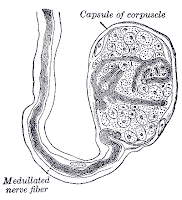Home › Skin senses › Skin sensitive to touch › Tactile defensiveness - tactile sensitivity
Tactile defensiveness (tactile sensitivity) is a sensory processing disorder in which the affected person experiences hyperarousal and exaggerated sensitivity to touch resulting in great distress and discomfort.
About 75% of the boys with 'fragile X syndrome' and some girls with full X mutation are found to suffer from tactile sensitivity.
The daily life of the tactile defensiveness affected person becomes very miserable. The daily routines like changing dress, brushing teeth and taking bath become arduous tasks. Some of the reactions of the affected children are as follows.
- The tactile defensiveness affected child may be greatly distressed by gentle touch.He may hate being touched on the face.
- He may hate coarse clothes. The very feel of the dress on him may distress him.
- The tactile defensiveness affected person will dislike anything around the neck like tie, jewellery and shirt collar.
- The person with tactile sensory processing disorder may dislike walking bare-footed and the feel of grass, soil or carpet may annoy him.
- The tactile defensiveness affected may dislike touching anything slimy and sticky.
- The sensory processing disorder affected child may dislike brushing teeth and a visit to a dentist becomes an ordeal.
- The tactile defensiveness affected person may lash out if somebody bumps on to him accidentally or touches or hugs him from behind.
- Group games are disliked by him and the possibility of touched by others will be avoided by him (even holding hands of partner).
- He may suffer from bed-wetting, confusion and motor muscle coordination difficulties.
- Strong preferences of foods may be there and the affected may dislike texture of certain food items.
- The tactile defensiveness affected person may dislike vibrating toys.
- He may dislike wind blowing on his body and may so sensitivity to change of temperatures.
The real remedy lies with parents and people in close contact with sensitivity affected child understanding the real problem of tactile defensiveness.
Just imagine a spider crawling on tour arm or your arm being rubbed with a sand paper and your reactions to it.
Similarly a person afflicted with tactile defensiveness has extreme sensitivity and reacts even to normal stimuli.
The sensitivity can be alleviated to great extent by Wilbarger Brushing Protocol, wherein the child's skin is brushed daily with soft surgical brush using a firm pressure.
Repetition of this process over an extent of time will reduce the hyper sensitivity of the skin of the affected person.
The joints of the arms and legs are pressed for sometime regularly. A finger is swiped inside the mouth to desensitize the mouth and reduce sensitivity.
In these treatments there is slow but sure reduction in the tactile defensiveness of the affected child. Soft and seamless clothing for the sensitivity affected children helps a lot.

.jpg)


